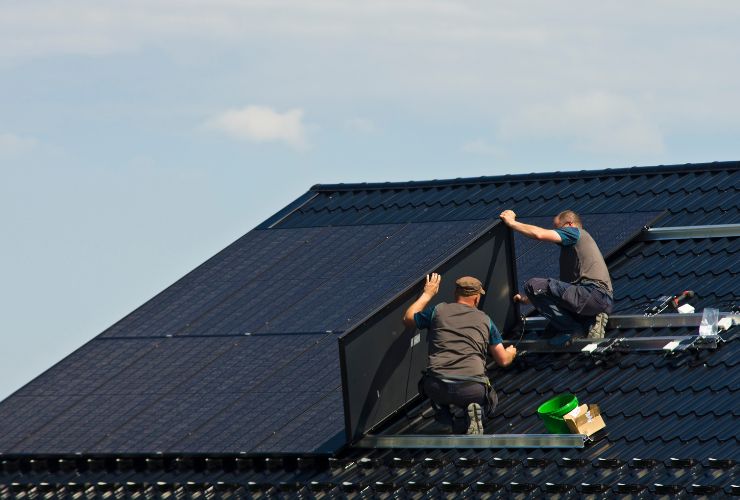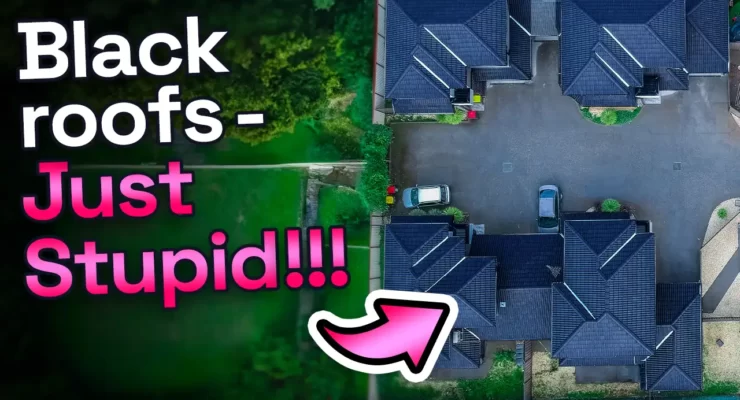Fast read
The debate on whether to ban black roofs for energy efficiency is nuanced. While light-coloured roofs can reflect heat and reduce energy consumption, the discussion should consider a holistic approach to home design, such as incorporating solar power panels, which themselves are black but offer shading and energy benefits.
Policy should also consider the affordability of alternative materials and the impact on low-income communities. Rather than an outright ban on black roofs, a comprehensive strategy that includes promoting lighter colours, reflective coatings, green roofs, and solar panels may be more cost-effective as well as both energy efficiency and environmental sustainability.
Before making any investments in renewable energy solutions like solar panels or batteries, it's advisable to consult with qualified local experts.
Black Roofs get extremely hot – why do we need them?
As part of the discussion and move to more energy-efficient homes, the colour and design of roofs have been considered and discussed for an extended period. It is known that black materials absorb more heat than light colours, which reflect heat as such black roofs on homes will lead to more heat being absorbed into the roof of a home and so heating the home, particularly during the hot Australian summers.
This can lead to air conditioning cooling the home because of the increased heat. Therefore, the use of electricity and home running costs increase.
Is banning the solution?
It would seem to make sense that if roofs were of a light colour, this would reduce the home’s energy consumption and the temperature. While on its own, it may make sense when you look at the more detailed design of the home. A range of considerations could reduce the value of banning black roofs on their own.
It makes sense that homes are designed and built with solar panels by default. Solar panels are black themselves and installed on (100mm above) the roof surface. While solar panels can be black, they are raised off the roof and shade the roof from the sun’s heat. This prevents heat build-up in the roof cavity.
Energy Efficiency Concerns
Thinking about keeping homes cool and energy-efficient in a smart way is important. A good idea is to use large, weather-resistant awnings to cover windows. These awnings block out the hot sun but still let fresh air in, this helps cool down the house without needing lots of energy.
But there’s another problem as houses are often built extremely close together in neighbourhoods. This stops air from moving freely between them.
When lots of houses are close together, they can make each other even hotter. This is because all the heat gets trapped between them.
To fix this, we need to rethink how we build neighbourhoods. Giving more space between houses would let air flow better. This would keep homes cooler naturally and save energy.
So, by using expansive awnings and providing homes with additional space, we can keep them cool and reduce energy consumption.

How would a black roof ban affect people?
A complete prohibition on black roofs would have several effects that should be carefully considered. First off, more expensive prices for alternate roofing materials and colours may make them less affordable for low-income neighbourhoods. Second, the ban would strain families and businesses by necessitating hefty investments in building retrofits. Thirdly, acquiring universal support and compliance with the prohibition may be challenging because of cultural and aesthetic preferences.
The discussion of black roofs calls for a sophisticated viewpoint that balances environmental and energy efficiency issues. However, black roofs can potentially increase the urban heat island effect. They also present practical cost-saving measures and possible energy savings.
Policymakers should prioritise encouraging the adoption of sustainable roofing practices. This includes using lighter colours, reflective coatings, green roofs, and solar systems rather than outright prohibiting them.
This strategy guarantees a comprehensive response that considers both the need for energy efficiency and the environmental impact, paving the path for a more sustainable and robust urban environment. Many options within the home can make it more energy efficient with passive design, and having a lighter colour roof over black has its benefits. A wide range of options exist to make a home energy efficient outside this, reducing the value and need for black roofs to be banned.



